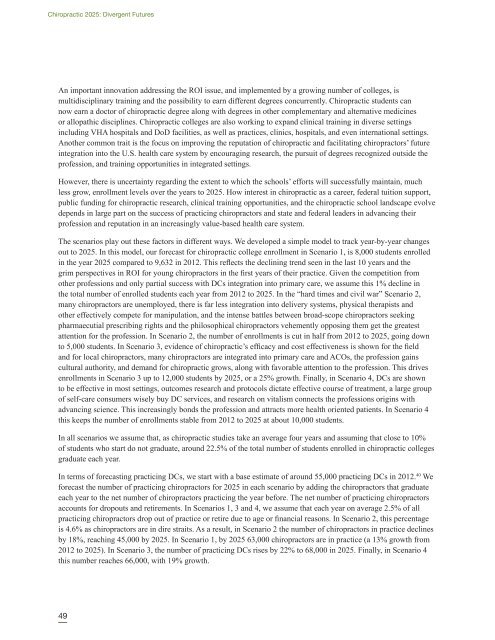Chiropractic 2025:
Chiropractic 2025:
Chiropractic 2025:
You also want an ePaper? Increase the reach of your titles
YUMPU automatically turns print PDFs into web optimized ePapers that Google loves.
<strong>Chiropractic</strong> <strong>2025</strong>: Divergent Futures<br />
An important innovation addressing the ROI issue, and implemented by a growing number of colleges, is<br />
multidisciplinary training and the possibility to earn different degrees concurrently. <strong>Chiropractic</strong> students can<br />
now earn a doctor of chiropractic degree along with degrees in other complementary and alternative medicines<br />
or allopathic disciplines. <strong>Chiropractic</strong> colleges are also working to expand clinical training in diverse settings<br />
including VHA hospitals and DoD facilities, as well as practices, clinics, hospitals, and even international settings.<br />
Another common trait is the focus on improving the reputation of chiropractic and facilitating chiropractors’ future<br />
integration into the U.S. health care system by encouraging research, the pursuit of degrees recognized outside the<br />
profession, and training opportunities in integrated settings.<br />
However, there is uncertainty regarding the extent to which the schools’ efforts will successfully maintain, much<br />
less grow, enrollment levels over the years to <strong>2025</strong>. How interest in chiropractic as a career, federal tuition support,<br />
public funding for chiropractic research, clinical training opportunities, and the chiropractic school landscape evolve<br />
depends in large part on the success of practicing chiropractors and state and federal leaders in advancing their<br />
profession and reputation in an increasingly value-based health care system.<br />
The scenarios play out these factors in different ways. We developed a simple model to track year-by-year changes<br />
out to <strong>2025</strong>. In this model, our forecast for chiropractic college enrollment in Scenario 1, is 8,000 students enrolled<br />
in the year <strong>2025</strong> compared to 9,632 in 2012. This reflects the declining trend seen in the last 10 years and the<br />
grim perspectives in ROI for young chiropractors in the first years of their practice. Given the competition from<br />
other professions and only partial success with DCs integration into primary care, we assume this 1% decline in<br />
the total number of enrolled students each year from 2012 to <strong>2025</strong>. In the “hard times and civil war” Scenario 2,<br />
many chiropractors are unemployed, there is far less integration into delivery systems, physical therapists and<br />
other effectively compete for manipulation, and the intense battles between broad-scope chiropractors seeking<br />
pharmaecutial prescribing rights and the philosophical chiropractors vehemently opposing them get the greatest<br />
attention for the profession. In Scenario 2, the number of enrollments is cut in half from 2012 to <strong>2025</strong>, going down<br />
to 5,000 students. In Scenario 3, evidence of chiropractic’s efficacy and cost effectiveness is shown for the field<br />
and for local chiropractors, many chiropractors are integrated into primary care and ACOs, the profession gains<br />
cultural authority, and demand for chiropractic grows, along with favorable attention to the profession. This drives<br />
enrollments in Scenario 3 up to 12,000 students by <strong>2025</strong>, or a 25% growth. Finally, in Scenario 4, DCs are shown<br />
to be effective in most settings, outcomes research and protocols dictate effective course of treatment, a large group<br />
of self-care consumers wisely buy DC services, and research on vitalism connects the professions origins with<br />
advancing science. This increasingly bonds the profession and attracts more health oriented patients. In Scenario 4<br />
this keeps the number of enrollments stable from 2012 to <strong>2025</strong> at about 10,000 students.<br />
In all scenarios we assume that, as chiropractic studies take an average four years and assuming that close to 10%<br />
of students who start do not graduate, around 22.5% of the total number of students enrolled in chiropractic colleges<br />
graduate each year.<br />
In terms of forecasting practicing DCs, we start with a base estimate of around 55,000 practicing DCs in 2012. 40 We<br />
forecast the number of practicing chiropractors for <strong>2025</strong> in each scenario by adding the chiropractors that graduate<br />
each year to the net number of chiropractors practicing the year before. The net number of practicing chiropractors<br />
accounts for dropouts and retirements. In Scenarios 1, 3 and 4, we assume that each year on average 2.5% of all<br />
practicing chiropractors drop out of practice or retire due to age or financial reasons. In Scenario 2, this percentage<br />
is 4.6% as chiropractors are in dire straits. As a result, in Scenario 2 the number of chiropractors in practice declines<br />
by 18%, reaching 45,000 by <strong>2025</strong>. In Scenario 1, by <strong>2025</strong> 63,000 chiropractors are in practice (a 13% growth from<br />
2012 to <strong>2025</strong>). In Scenario 3, the number of practicing DCs rises by 22% to 68,000 in <strong>2025</strong>. Finally, in Scenario 4<br />
this number reaches 66,000, with 19% growth.<br />
49


